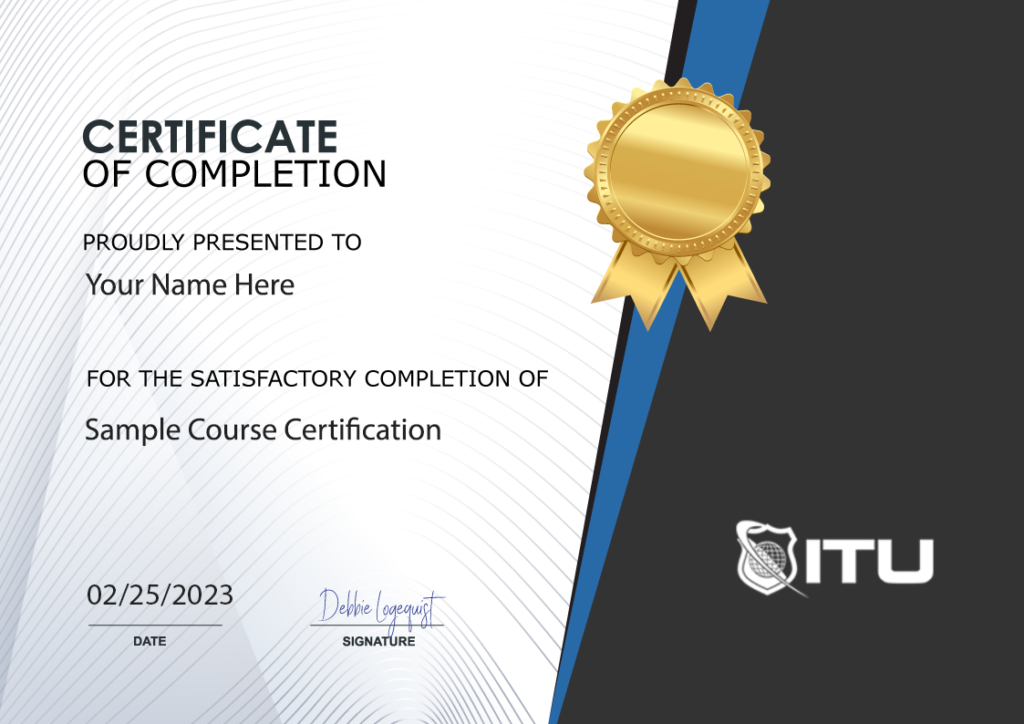2025 CompTIA A+ Certification 220-1201 & 220-1202 Training
Kickstart your IT career with our comprehensive CompTIA A+ Certification 220-1201 & 220-1202 Training Course. Designed for both beginners and professionals, this course equips you with in-depth knowledge of hardware, networking, mobile devices, operating systems, and cybersecurity, preparing you for a wide range of entry-level IT roles.
Included In This Course



Closed Captions



Certificate of Completion
Course Description for CompTIA A+ Certification 220-1201 & 220-1202 Training
Prepare to launch your IT career with our comprehensive CompTIA A+ Certification Training, specifically designed for the 220-1201 and 220-1202 exam series. This course provides an in-depth understanding of essential hardware, networking, mobile devices, operating systems, security, virtualization, cloud computing, and professional operational procedures. It’s the foundational certification required by many employers and widely recognized across the IT industry.
You’ll gain hands-on skills in troubleshooting, installing, and maintaining a wide range of technology systems. This training covers everything from mobile devices and network troubleshooting to system hardware configuration and cybersecurity best practices. With real-world labs and performance-based learning, you’ll be fully equipped to pass the CompTIA A+ exams and succeed in a variety of entry-level IT roles.
What You Will Learn in CompTIA A+ IT Technician Course
This course equips you with the practical knowledge and technical skills needed to support today’s core IT systems. By the end of the training, you’ll confidently handle device configuration, security implementation, and problem resolution.
- Configure and support mobile devices including Android and iOS systems
- Understand networking concepts like IP addressing, DNS, DHCP, and VPNs
- Install and troubleshoot hardware components such as CPUs, RAM, printers, and motherboards
- Deploy and manage multiple operating systems including Windows, Linux, and macOS
- Execute virtualization and cloud computing tasks in real-world environments
- Implement cybersecurity measures such as firewalls, encryption, and malware prevention
- Use ticketing systems, backup protocols, and scripting fundamentals in IT operations
- Apply structured troubleshooting methods for technical and security-related issues
Exam Objectives for CompTIA A+ 220-1201 & 220-1202 Certification
This course prepares you for the CompTIA A+ certification, governed by CompTIA. The certification is split into two exams: 220-1201 and 220-1202, each covering different domains of IT knowledge.
- 220-1201: Mobile Devices, Networking, Hardware, Virtualization & Cloud Computing
- 220-1202: Operating Systems, Security, Software Troubleshooting, Operational Procedures
- Exam includes multiple-choice, drag and drop, and performance-based questions
- Each exam is 90 minutes long, with a maximum of 90 questions per exam
Who This CompTIA A+ Certification Course is For
Whether you’re new to IT or looking to validate your foundational tech skills, this course is perfect for learners of all backgrounds. It’s especially beneficial for those starting their careers or transitioning into IT support roles.
- Beginners with little or no technical experience
- Students pursuing a career in Information Technology
- Career changers seeking entry-level IT support positions
- Help desk technicians and computer support specialists
- Professionals aiming for industry-recognized certification
Possible Jobs You Can Get With This CompTIA A+ Knowledge
Achieving CompTIA A+ certification opens the door to many job opportunities in IT. These roles span a variety of industries and require foundational technical support skills.
- IT Support Specialist
- Help Desk Technician
- Desktop Support Technician
- Technical Support Specialist
- Field Service Technician
- System Support Administrator
- Junior Network Administrator
Average Industry Salaries for People with CompTIA A+ Certification
Gaining your CompTIA A+ certification can lead to competitive entry-level salaries in the IT industry. Your earning potential may vary depending on location, experience, and specific role.
- IT Support Specialist: $45,000 – $60,000/year
- Help Desk Technician: $40,000 – $55,000/year
- Desktop Support Technician: $50,000 – $65,000/year
- Technical Support Specialist: $48,000 – $62,000/year
- Junior Network Administrator: $55,000 – $70,000/year
Get Started Today with CompTIA A+ Certification Training
Ready to break into the tech industry and launch a rewarding IT career? Our CompTIA A+ training course is your first step toward becoming a certified IT professional. With expert instruction, hands-on labs, and comprehensive exam preparation, you’ll gain the confidence and skills needed to pass the exams and excel in the workplace.
Don’t wait—start building your IT future today. Enroll now and take the first step toward earning your CompTIA A+ certification and opening doors to exciting new career opportunities.
Frequently Asked Questions
What are the key differences between the CompTIA A+ 220-1201 and 220-1202 exams?
The CompTIA A+ certification consists of two separate exams: 220-1201 and 220-1202, each focusing on distinct areas of IT knowledge. Understanding these differences is crucial for effective preparation.
The 220-1201 exam primarily covers:
- Mobile Devices: This includes the configuration and support of Android and iOS devices, understanding mobile operating systems, and troubleshooting issues.
- Networking: Key concepts include IP addressing, DNS, DHCP, and VPNs, as well as practical skills in setting up networks.
- Hardware: Focus on installation, troubleshooting, and configuration of physical components like CPUs, RAM, and printers.
- Virtualization and Cloud Computing: Understanding virtualization concepts and cloud services, which are increasingly relevant in today’s IT landscape.
On the other hand, the 220-1202 exam emphasizes:
- Operating Systems: This section covers installation, configuration, and troubleshooting of various operating systems including Windows, Linux, and macOS.
- Security: Important topics include implementing cybersecurity measures, understanding firewalls, and malware prevention strategies.
- Software Troubleshooting: Techniques for diagnosing and resolving software-related issues.
- Operational Procedures: Best practices for IT operations, including ticketing systems and backup protocols.
In summary, 220-1201 focuses more on hardware and networking, while 220-1202 is centered around software, operating systems, and security practices. Understanding these areas will help you tailor your study plan effectively and improve your chances of passing both exams.
What are some effective study strategies for passing the CompTIA A+ 220-1201 and 220-1202 exams?
Preparing for the CompTIA A+ certification exams 220-1201 and 220-1202 requires a structured study approach. Here are some effective strategies to help you succeed:
- Create a Study Schedule: Allocate specific times each week for studying various topics. Consistency is key, so try to stick to your schedule and review regularly.
- Utilize Official Study Materials: Make use of the official CompTIA study guides and resources. These materials are specifically designed to cover all exam objectives and will provide you with the most relevant information.
- Hands-On Practice: Engage in practical exercises, such as assembling hardware components, configuring networks, or setting up operating systems. Real-world experience will solidify your understanding and make you more confident during the exams.
- Join Study Groups: Collaborate with fellow learners in study groups. Discussing topics with peers can reinforce your knowledge and provide different perspectives on complex subjects.
- Take Practice Exams: Utilize practice tests to assess your knowledge and familiarize yourself with the exam format. These tests can highlight areas where you need further study and build your test-taking skills.
- Focus on Weak Areas: After taking practice tests, identify areas where you scored lower and dedicate extra time to those topics. This targeted approach ensures you are well-rounded in your knowledge.
- Review and Revise Regularly: Consistently review material to reinforce your memory. Use flashcards, summary sheets, or mind maps to aid in retention.
By implementing these strategies, you can create a robust study plan that will enhance your understanding of the material and improve your chances of passing the CompTIA A+ 220-1201 and 220-1202 exams.
What are the most common misconceptions about the CompTIA A+ certification?
Many individuals interested in pursuing the CompTIA A+ certification hold misconceptions that can hinder their preparation and understanding of the certification's value. Here are some of the most prevalent myths:
- Myth 1: CompTIA A+ is not recognized in the industry. This is false; CompTIA A+ is one of the most widely recognized entry-level certifications in the IT field. Many employers specifically list it as a requirement for IT support positions, validating its credibility.
- Myth 2: You need extensive IT experience to pass the exams. While having some background in IT can be beneficial, the A+ certification is designed for beginners. The course covers foundational knowledge, making it accessible even for those with limited experience.
- Myth 3: The certification is only for help desk jobs. Although many individuals pursue A+ for help desk roles, the certification opens doors to various entry-level IT positions, such as network administrators, desktop support technicians, and more.
- Myth 4: One exam covers everything you need to know. CompTIA A+ consists of two separate exams, 220-1201 and 220-1202, which cover different domains. It’s essential to prepare for both to gain a comprehensive understanding of IT fundamentals.
- Myth 5: You can pass without hands-on experience. While theoretical knowledge is crucial, hands-on experience is vital for success. Practical skills help in troubleshooting real-world issues and are heavily emphasized in the exams.
Debunking these misconceptions helps potential candidates approach their studies with a clear understanding of the certification's value and the commitment required for success.
How can CompTIA A+ certification enhance my career prospects in IT?
Obtaining CompTIA A+ certification significantly enhances your career prospects in the IT industry by providing you with a valuable credential that demonstrates your foundational skills and knowledge. Here are several ways the certification can benefit your career:
- Industry Recognition: CompTIA A+ is a globally recognized certification that signals to employers that you possess essential IT skills. Many organizations list it as a prerequisite for IT support roles.
- Entry-Level Opportunities: The certification opens doors to numerous entry-level positions such as IT Support Specialist, Help Desk Technician, and Desktop Support Technician, allowing you to start your career in IT.
- Foundation for Advanced Certifications: A+ serves as a stepping stone for more advanced certifications like CompTIA Network+ and CompTIA Security+. It builds a solid foundation upon which you can expand your expertise in specialized areas.
- Improved Earning Potential: With A+ certification, you can command a higher salary compared to non-certified peers. Entry-level IT roles typically range from $40,000 to $70,000 annually, depending on the position and location.
- Comprehensive Skill Set: The training equips you with a broad range of skills, from hardware and networking to security and troubleshooting, making you a versatile candidate for various roles in IT.
- Networking Opportunities: Being certified allows you to connect with other professionals in the field, expanding your network and providing opportunities for collaboration and career advancement.
- Confidence in Your Abilities: Achieving certification boosts your confidence, as you have validated your skills and knowledge in IT. This self-assurance can positively impact your performance in job interviews and on the job.
In summary, CompTIA A+ certification enhances your career prospects by validating your skills, opening entry-level job opportunities, and providing a solid foundation for future learning and professional growth in the ever-evolving IT industry.
What role do hands-on labs play in CompTIA A+ certification training?
Hands-on labs are a critical component of CompTIA A+ certification training, providing practical experience that is essential for mastering the material and applying theoretical knowledge to real-world scenarios. Here’s how hands-on labs contribute to effective learning:
- Real-World Application: Labs simulate actual IT environments where learners can practice skills like hardware installation, system configuration, and troubleshooting. This direct application of knowledge enhances comprehension and retention.
- Skill Development: Hands-on experience allows students to develop essential technical skills. For instance, configuring networks, setting up operating systems, and using various software tools can be practiced until proficiency is achieved.
- Confidence Building: Engaging in practical tasks helps build confidence. Understanding how to handle technical issues in a lab setting prepares students for similar challenges they may face in the workplace.
- Problem-Solving Skills: During lab exercises, learners are often presented with scenarios that require troubleshooting and problem resolution. This experience fosters critical thinking and enhances the ability to diagnose and fix issues effectively.
- Preparation for Performance-Based Testing: The CompTIA A+ exams include performance-based questions that assess practical skills. Hands-on labs directly prepare candidates for these types of questions, improving their chances of success.
- Engagement and Motivation: Interactive learning through labs can increase student engagement. Practical tasks can break the monotony of theoretical study, making the learning experience more enjoyable and motivating.
Overall, hands-on labs are indispensable in CompTIA A+ certification training, equipping learners with the practical skills needed to excel in the IT field and ensuring they are well-prepared for the certification exams.
Blogs of Interest Related to This Course
- CompTIA Network+ vs CCNA: A Detailed Guide to Choosing Your Path
- CompTIA A+ Guide to IT Technical Support
- Ace Your Exam: Get Ready with the CompTIA A+ 1101 Practice Test from ITU Online
- Boost Your Knowledge with CompTIA A+ Flashcards
- CompTIA A+ 1101 Practice Exam Questions: Mastering Each Domain and Sample Questions
- Comptia A+ 1102 Practice Exam Questions: Mastering Each Domain and Sample Questions
- CompTIA A+ Certification: The Perfect Certification to Begin Your IT Career
- Free CompTIA A+ Training: Explore the Best Online Courses and Tutorials
- CompTIA A+ Training Free: Unlocking the Path to IT Certification
- Systems Administrator: The Orchestrator of an Organization's IT Ecosystem
Proudly DisplayYour Achievement
Upon completion of your training, you’ll receive a personalized certificate of completion to help validate to others your new skills.
CompTIA A+ 1200 Series (220-1201 & 220-1202) Course Content
Module 4 - Operating Systems
- 4.1 Workstation Operating Systems
- 4.2 Common File System Types
- 4.3 Operating System Installation Types
- 4.4 Operating System Boot Methods
- 4.5 Storage Partitioning
- 4.5.1 Demo - Working with Storage Partitions
- 4.6 Identifying Windows Editions
- 4.7 Windows Upgrades
- 4.8 Windows OS Installations
- 4.9 Using Windows Task Manager
- 4.9.1 Demo - Working with Windows Task Manager
- 4.10 MMC Snap-ins
- 4.10.1 Demo - Working with MMC Snap-ins
- 4.11 Windows Operating System Tools
- 4.12 Microsoft Command Line Tools
- 4.12.1 Demo - Working with Microsoft Command Prompt
- 4.13 Configuring Microsoft Windows Settings
- 4.14 Configuring Windows Power Options
- 4.14.1 Demo - Working with Windows Power Options
- 4.15 Windows File Explorer
- 4.15.1 Demo - Working with File Explorer
- 4.16 Windows Domains vs Workgroups
- 4.17 macOS System Configuration
- 4.17.1 Demo - macOS Features and Tools
- 4.18 Linux Components
- 4.19 Linux Tools
- 4.20 Common Application Installation
Module 1 - Mobile Devices
- 1.0 CompTIA A+ Course Intro
- 1.1 Mobile Device Hardware and Components
- 1.2 Mobile Device Connections and Accessories
- 1.3 Mobile Device Operating Systems
- 1.4 Troubleshooting Mobile Devices
- 1.5 Mobile Device,OS and Application Issues
- 1.6 Mobile Device,OS and Application Security
- 1.7 Identifying Connection Settings in Android
- 1.8 Identifying Connection Settings in iOS
Module 2 - Networking
- 2.1 Network Architecture
- 2.2 Ports and Protocols
- 2.3 Wireless Networking
- 2.4 Network Hosts and Services
- 2.5 DNS and DHCP
- 2.5.1 Demo - Working with DNS and DHCP
- 2.6 VPNs and VLANs
- 2.7 Network Devices
- 2.8 Basic SOHO Configuration
- 2.9 Internet Connections and Network Types
- 2.10 Networking Tools
- 2.11 Networking in Windows
- 2.11.1 Demo - Configuring Networking in Windows
- 2.12 Networking Commands
- 2.12.1 Demo - Working with Networking Commands
- 2.13 Troubleshooting Network Issues
Module 3 - Hardware
- 3.1 Display Components and Attributes
- 3.2 Basic Cables and Connections
- 3.3 Network Cables and Connections
- 3.4 Storage Devices and Connections
- 3.5 Introduction to RAID
- 3.6 Motherboards and Form Factors
- 3.7 Motherboard Connections
- 3.8 BIOS and UEFI
- 3.9 CPUs and CPU Architecture
- 3.10 Expansion Cards
- 3.11 System Cooling
- 3.12 Power Supply Units
- 3.13 Printers and Multifunction Devices
- 3.14 Printer Maintenance
- 3.15 Troubleshooting Computer Components
- 3.16 Troubleshooting Storage and RAID Issues
- 3.17 Troubleshooting Video and Display Issues
- 3.18 Troubleshooting Printer Issues
Module 5 - Virtualization and Cloud Computing
- 5.1 Virtualization Concepts
- 5.1.1 Demo - Working with Virtual Machines
- 5.2 Cloud Computing
- 5.2.1 Demo - Working with the Cloud
- 5.3 Cloud Productivity Tools
Module 6 - Security
- 6.1 Physical Security
- 6.2 Physical Access Security
- 6.3 Logical Security
- 6.4 Windows Security - Firewalls and Antivirus
- 6.4.1 Demo - Working with the Windows Firewalls and Antivirus
- 6.5 Windows Security Users and Groups
- 6.6 Windows Security - NTFS and Share Permissions
- 6.6.1 Demo - Working with NTFS and Share Permissions
- 6.7 Windows Security - Active Directory
- 6.8 Windows Security - Data Encryption
- 6.9 Wireless Security
- 6.10 Malware Types
- 6.11 Malware Detection and Prevention
- 6.12 Social Engineering
- 6.13 Security Threats
- 6.13.1 Demo - Security Vulnerabilities
- 6.14 Malware Removal Process
- 6.15 Workstation Security
- 6.16 Data Destruction Concepts
- 6.17 SOHO Network Security
- 6.18 Browser Security Settings
- 6.19 Troubleshooting PC Security Issues
Module 7 - Operational Procedures
- 7.1 Ticketing Systems
- 7.2 Asset Management
- 7.3 Document Types
- 7.4 Change Management
- 7.5 Workstation Backup and Recovery
- 7.6 Common Safety Procedures
- 7.7 Environmental Impact and Controls
- 7.8 Licensing and Policy Concepts
- 7.9 Communication and Professionalism
- 7.10 Basics of Scripting
- 7.11 Remote Access Technologies
- 7.12 Basics of Artificial Intelligence
- 7.13 Troubleshooting Methodology
- 7.14 CompTIA A+ Course Closeout
| 5 star | 82 | 82% |
| 4 star | 17 | 17% |
| 3 star | 1 | 1% |
| 2 star | 0% | |
| 1 star | 0% |
Sorry, no reviews match your current selections

Subscribe To All-Access
Lock In $16.99 / Month Forever
Access this course and over 2,900 hours of focused IT training. Start your first month for only $1.00. Then lock in only $16.99 / month for life.
- Get Every Course
- Free Updates / New Content Added
- 2,900+ Hours of IT Training
- Price Lock Guarantee
- Games / Flashcards
- 22,000+ Practice Questions
- AI Study Buddy
- Certificates of Completion
$49.99 $16.99 Monthly
$49.00 Original price was: $49.00.$14.99Current price is: $14.99.





good
Smooth delivery and easy access to LMS. Good to see that the LMS offers progress tracking. Would be great if badges were offered on completion of courses to share via Credly to future employers.